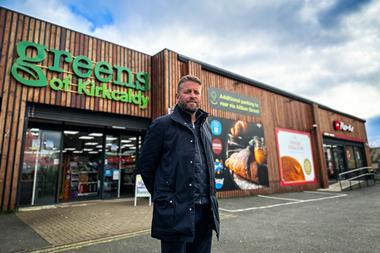The major retailers must brace themselves for the discounters pushing into ready meals, fruit and veg and also non-food.
Amy Balchin reports
Ready meals, fresh produce and non-food will be the next challenges for the UK hard discounters - and potential threats to the grocery multiples. This was the stark prediction made at the IGD annual global conference in Westminster.
Debating the phenomenal rise of hard discounting in a panel discussion, Steve Newiss, vice-president global customers, Kraft Foods, warned that long-life and dry food items would not be the only lines stacked on the hard discounters’ shelves in the future. “The discounting model seems to be working and it is now getting into non-food.”
Discounters have already seen some success in selling electrical goods in their stores with limited stock offers being snapped up by consumers, Newiss said, adding that he saw them continuing to add more fresh produce, ready meals and healthy eating alternatives to their assortments as consumer demand grew.
However, he said, simply increasing their ranges would not be enough to guarantee a healthy slice of the market. “As other retailers move into prepared food, can the discounter maintain that quality of offer? It is going to be the next battle.”
The other members of the panel agreed that there would always be a place for top-end retailers, but argued that they would have to respond intelligently to the discounting threat. Neil Dickenson, Johnson & Johnson customer development director, said that product lifecycles were becoming shorter and to compete with the discounters other retailers would have to remain innovative and offer genuine value to customers. He said: “We have to make sure we are as
cost-efficient as we can be. The challenge for us as manufacturers is in what way can we drive forward?”
McBride chief executive Mike Handley, added: “Discounting is here to stay and will grow. Retailing is about satisfying customers - they want value. If you want a full service shop, an Aldi will not give it to you, but retailers are having to build discounting into their full service shop.”
Of course, in the UK, that is essentially what the multiples have already done and their soft discounting tactics are widely seen to have stifled much of the hard-discounting threat - that and the typically secondary location of their stores.
Nevertheless, said IGD chief executive Joanne Denney-Finch, the industry was now in the “age of the discounter”. She pointed out that since the early 1990s, discount stores in Europe had doubled in number to 30,000.
Even in the UK, the hard discounting phenomenon would continue to grow, predicted Andrew Garden, Procter & Gamble general manager for Western Europe.
“It is clear if we talk to the people who shop in discounters that they love shopping in these stores.
“Clearly, they are more developed in Germany and at different stages elsewhere, but in every single country discounters will continue to grow.”
One of the chief reasons for their success in Europe, the US and Japan is that they have been addressing their traditional weakness of limited range by adapting and increasing their offer. Garden added that by avoiding the promotional tactics of some of the multiples, they have given consumers a consistently clear price message.
“When we talk to customers who shop at Aldi or Lidl, they reject the notion of big promotions,” he said. “It is fantastic when you see products with promotions you want, but then you think - ‘I am getting ripped off on that product the next time I go and buy it’.”
However, agreed the panel, hard discounters needed to do a better job of balancing a global strategy with local knowledge if they wanted global success.
“We are in a time of evolution at the moment,” said Newiss. “Food tends to be local - it is all geared to a local taste. You need good relations between yourself and local distributors - there are a lot of pitfalls and you do need help with local issues.”
Handley advised: “Listen to your customers, don’t try and second guess what they want.”
Garden added: “Be prepared to adapt. The formula you may need in a new market may be fundamentally different.”
Amy Balchin reports
Ready meals, fresh produce and non-food will be the next challenges for the UK hard discounters - and potential threats to the grocery multiples. This was the stark prediction made at the IGD annual global conference in Westminster.
Debating the phenomenal rise of hard discounting in a panel discussion, Steve Newiss, vice-president global customers, Kraft Foods, warned that long-life and dry food items would not be the only lines stacked on the hard discounters’ shelves in the future. “The discounting model seems to be working and it is now getting into non-food.”
Discounters have already seen some success in selling electrical goods in their stores with limited stock offers being snapped up by consumers, Newiss said, adding that he saw them continuing to add more fresh produce, ready meals and healthy eating alternatives to their assortments as consumer demand grew.
However, he said, simply increasing their ranges would not be enough to guarantee a healthy slice of the market. “As other retailers move into prepared food, can the discounter maintain that quality of offer? It is going to be the next battle.”
The other members of the panel agreed that there would always be a place for top-end retailers, but argued that they would have to respond intelligently to the discounting threat. Neil Dickenson, Johnson & Johnson customer development director, said that product lifecycles were becoming shorter and to compete with the discounters other retailers would have to remain innovative and offer genuine value to customers. He said: “We have to make sure we are as
cost-efficient as we can be. The challenge for us as manufacturers is in what way can we drive forward?”
McBride chief executive Mike Handley, added: “Discounting is here to stay and will grow. Retailing is about satisfying customers - they want value. If you want a full service shop, an Aldi will not give it to you, but retailers are having to build discounting into their full service shop.”
Of course, in the UK, that is essentially what the multiples have already done and their soft discounting tactics are widely seen to have stifled much of the hard-discounting threat - that and the typically secondary location of their stores.
Nevertheless, said IGD chief executive Joanne Denney-Finch, the industry was now in the “age of the discounter”. She pointed out that since the early 1990s, discount stores in Europe had doubled in number to 30,000.
Even in the UK, the hard discounting phenomenon would continue to grow, predicted Andrew Garden, Procter & Gamble general manager for Western Europe.
“It is clear if we talk to the people who shop in discounters that they love shopping in these stores.
“Clearly, they are more developed in Germany and at different stages elsewhere, but in every single country discounters will continue to grow.”
One of the chief reasons for their success in Europe, the US and Japan is that they have been addressing their traditional weakness of limited range by adapting and increasing their offer. Garden added that by avoiding the promotional tactics of some of the multiples, they have given consumers a consistently clear price message.
“When we talk to customers who shop at Aldi or Lidl, they reject the notion of big promotions,” he said. “It is fantastic when you see products with promotions you want, but then you think - ‘I am getting ripped off on that product the next time I go and buy it’.”
However, agreed the panel, hard discounters needed to do a better job of balancing a global strategy with local knowledge if they wanted global success.
“We are in a time of evolution at the moment,” said Newiss. “Food tends to be local - it is all geared to a local taste. You need good relations between yourself and local distributors - there are a lot of pitfalls and you do need help with local issues.”
Handley advised: “Listen to your customers, don’t try and second guess what they want.”
Garden added: “Be prepared to adapt. The formula you may need in a new market may be fundamentally different.”

















No comments yet